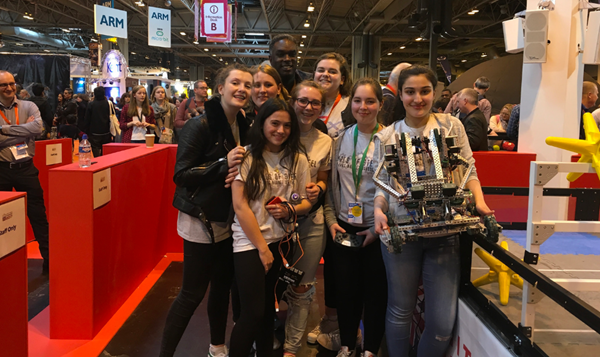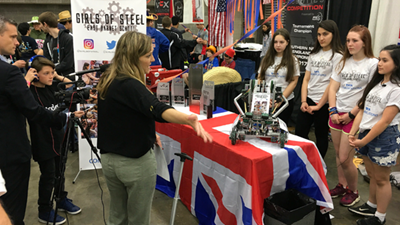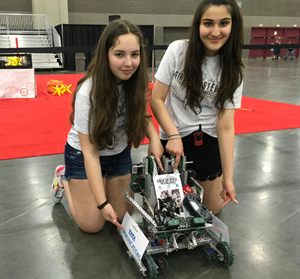& Construction

Integrated BIM tools, including Revit, AutoCAD, and Civil 3D
& Manufacturing

Professional CAD/CAM tools built on Inventor and AutoCAD
4 min read
At the East Barnet School on the outskirts of London, design teacher Steve Sadler once made a friendly bet with the dance teacher that he could recruit new members of his robotics team from among her dancers. “I kind of lured them from dance, going there every lunchtime,” he says. His message: “You girls can do this as well. It’s not just the boys.” At that time it was VEX Impact, mentors to the younger all-girl robotics team.
East Barnet’s additional all-girl robotics teams — the Girls of Steel — haven’t just done it, they’ve excelled, becoming VEX national champions in the U.K. and also traveled to the U.S. to compete in the world championships.

Sadler says that East Barnet has the largest design and technology faculty of any secondary school in the U.K., with a mix of 20 teachers and technicians on staff. They offer a range of learning options, including industrial design, product design, engineering, graphics, textiles, food, and photography, to the school’s 1,350 students. Sadler, an alumnus of the school himself, has now served on the faculty for 16 years.
His own involvement with robotics started in 2011, when he was researching new and fun ways to add an enhance the design and technology curriculum for all the students at East Barnet School. When he first started Robotics at EBS he had one iMac desktop to work with CAD, and eventually the faculty acquired a laser cutter and eventually a CNC machine. Through another connection, he was introduced to VEX Robotics, which offers robotics kits for STEM education. “It was very, very new,” he says. “I knew nothing about it.”
Sadler built two VEX robots on his own, driving them up and down the EBS corridors of the school to drum up interest from students. Soon he had put together a couple teams of four students to compete in the VEX national competition for the U.K. Even though they had only three months to prepare, he says, “To my surprise, we end up winning the event.”
Today, Sadler has scores of students signed up for the Autodesk Design Academy. In the program, each student takes several tutorials to build their expertise in CAD. Meanwhile, the school is also taking advantage of an enrichment program that allows courses to diverge from the national curriculum three afternoons a week, so long as the students are learning. That means that a total of 600 students in grades 7, 8, and 9 will rotate through CAD training that teaches them to use Autodesk applications and other types of professional-grade software, and also mobile design and collaboration apps.
At the same time, the 25-member robotics club continues to raise funds to cover the costs of equipment, competition fees and even travel and accomodation. “We’re quite good as a school at scrounging what we can,” Sadler says.
The students are also active users of Inventor and Fusion 360. Sadler himself has been using Fusion 360 for two years. When he started using it for surface modeling, he says, “I was amazed at how quickly I  could do it” in comparison to his experience using Solidworks.
could do it” in comparison to his experience using Solidworks.
One of the girls from last year’s team had previously worked only in 2D modeling, but she took to Fusion 360 so quickly that she was able to build a portfolio that helped her win admission to university. Sadler has gotten similar responses from former students of his already attending university; as he puts it, “They’ve been jaw dropped at how quickly they can create something.” Many students that have moved on from A Level to design universities have even found themselves except from their 1st year CAD modules as they have covered everything within their A Level courses. The new A Level Engineering students are also taking advantage of Autodesk CFD for analysis to help them improve in areas like molding, additive manufacturing as well as to optimise general project product performance.
He also got permission from the girls’ parents to miss three days of school so they could attend Autodesk University. It was a rousing success. “They absolutely loved the three days and found the time invaluable in such a way that they could have never have been taught those skills in the classroom” Sadler says. “They look at things in a completely different light now. They are SO buzzed up from it and motivated in such a positive way.”
Sadler says that the VEX competition enables him as a teacher and mentor to try new things with his students and for them to develop advanced skills. As the students learn to use Autodesk products and  other software, they are also learning better teamwork and communication, as well as acquiring skills in marketing and seeking sponsorships. That means getting on the phone, learning to pitch to companies, learning sell their brand, setting up meetings and collaborating through Office 365 and other many skills that will prove to be useful in later life.
other software, they are also learning better teamwork and communication, as well as acquiring skills in marketing and seeking sponsorships. That means getting on the phone, learning to pitch to companies, learning sell their brand, setting up meetings and collaborating through Office 365 and other many skills that will prove to be useful in later life.
“One of the things we try to do is push confidence among the students,” Sadler says. Recently this has included having the girls on the team present to C-level executives on the importance of robotics in education.
The success of East Barnet’s program is easy to see. Beyond the trophies the teams have brought home, five former students have now gone into do degrees and even careers in robotics and mechatronics. But even the younger girls impress Sadler with their maturity.
“They can quite confidently now stand in a hall in a convention center,” he says, “and I can quite comfortably sit in my chair knowing that they’ll do great.”
By clicking subscribe, I agree to receive the Fusion newsletter and acknowledge the Autodesk Privacy Statement.
Success!
May we collect and use your data?
Learn more about the Third Party Services we use and our Privacy Statement.May we collect and use your data to tailor your experience?
Explore the benefits of a customized experience by managing your privacy settings for this site or visit our Privacy Statement to learn more about your options.